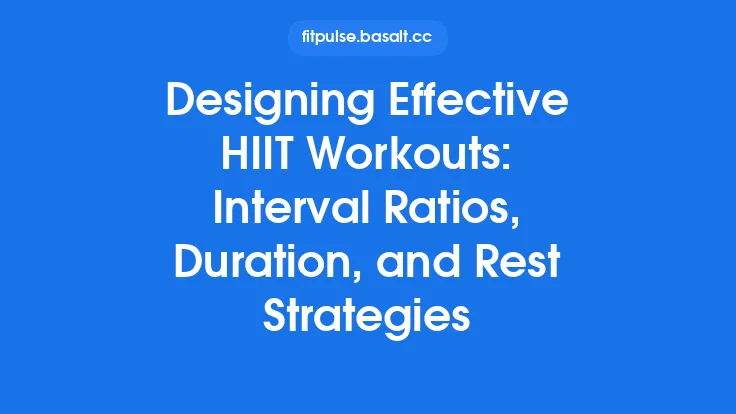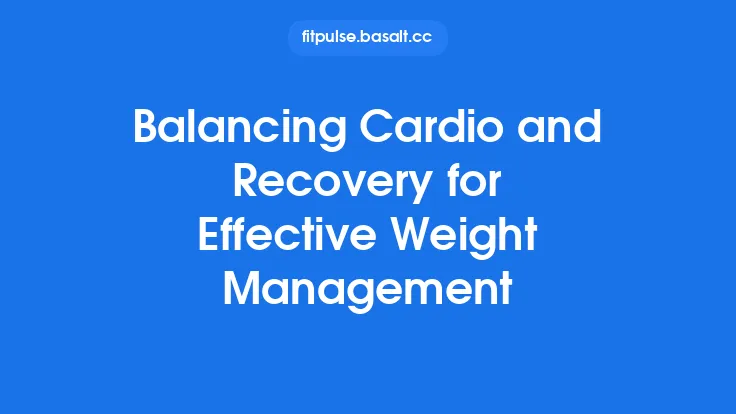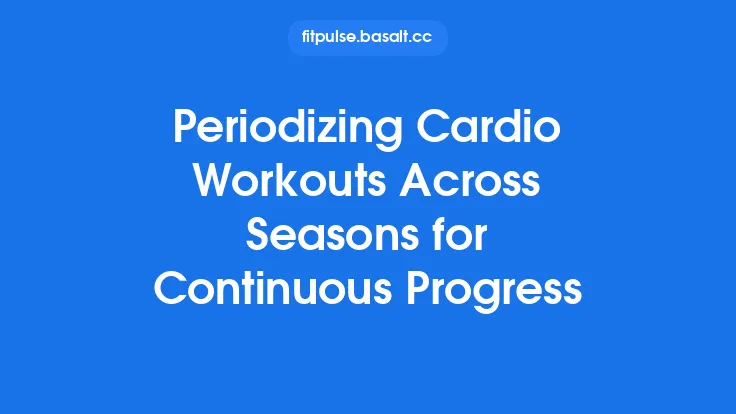High‑Intensity Interval Training (HIIT) delivers remarkable cardiovascular and metabolic benefits, but its potency also means that the body requires careful planning to avoid stagnation or overreaching. Periodization—systematically varying training variables over time—offers a science‑backed framework for weaving high‑intensity bouts into a broader training tapestry that includes low‑intensity work, recovery phases, and strategic de‑loads. By treating HIIT as a distinct training block rather than an isolated “add‑on,” athletes and recreational exercisers can sustain performance gains, protect joint and connective tissue health, and keep motivation high across months and even years.
Understanding Periodization Fundamentals for HIIT
Periodization is built on three hierarchical time frames:
| Level | Typical Duration | Primary Focus |
|---|---|---|
| Macrocycle | 3–12 months | Overall objectives (e.g., peak aerobic power for a race, long‑term health) |
| Mesocycle | 4–6 weeks | Specific adaptations (e.g., aerobic base, anaerobic capacity) |
| Microcycle | 1 week | Day‑to‑day training load, recovery, and skill work |
When applying these layers to HIIT, the key is to decide how many high‑intensity sessions belong in each mesocycle and what low‑intensity work will accompany them. The balance shifts depending on the athlete’s training age, injury history, and the ultimate performance or health goal.
Linear vs. Undulating vs. Block Periodization for HIIT
| Model | Description | How It Shapes HIIT/Low‑Intensity Balance |
|---|---|---|
| Linear | Gradual increase in intensity or volume over the macrocycle, followed by a taper. | Early mesocycles emphasize low‑intensity steady‑state (LISS) or moderate‑intensity continuous training (MICT) to build aerobic foundation. HIIT volume is modest at first, then ramps up (e.g., 2 → 3 → 4 sessions/week). |
| Undulating (or Wave) | Variables (intensity, volume, frequency) fluctuate week‑to‑week or even day‑to‑day. | A typical week might feature a “hard” HIIT day, a “moderate” interval day, and two low‑intensity recovery days. This model prevents monotony and can better manage fatigue for seasoned athletes. |
| Block | Training is organized into concentrated “blocks” that target a single quality (e.g., power, endurance) before moving to the next. | A 2‑week HIIT block (high frequency, high intensity) is sandwiched between 2‑week low‑intensity blocks that serve as active recovery and consolidation phases. |
Choosing a model depends on the athlete’s schedule, competition calendar, and personal preference. Many coaches blend approaches—using linear progression for the macrocycle while inserting undulating microcycles to fine‑tune readiness.
Designing a HIIT‑Centric Mesocycle
- Define the Primary Adaptation
- Aerobic power: Emphasize longer intervals (e.g., 3‑4 min at 90‑95 % HRmax) with moderate rest.
- Anaerobic capacity: Short, maximal efforts (e.g., 15‑30 s all‑out) with longer recovery.
- Set Session Frequency
- Beginners (≤6 months HIIT experience): 1–2 HIIT sessions per week, spaced ≥48 h apart.
- Intermediate (6 months–2 years): 2–3 sessions per week, with at least one low‑intensity day between any two HIIT days.
- Advanced (≥2 years): 3–4 sessions per week possible, but must be paired with systematic deload weeks.
- Allocate Low‑Intensity Volume
- Active Recovery: 30–60 min of zone 2 (60‑70 % HRmax) work the day after a HIIT session.
- Base Building: 2–3 longer (45‑90 min) zone 2 rides/runs per week during early mesocycles.
- Integrate Strength & Mobility
- 1–2 sessions of resistance training focusing on posterior chain, core stability, and joint mobility can be placed on low‑intensity days to support HIIT mechanics and reduce injury risk.
Microcycle Templates
Below are three interchangeable weekly templates that illustrate how high‑ and low‑intensity work can coexist. Adjust the exact duration and intensity based on the athlete’s HR zones, perceived exertion, and recovery metrics.
| Template A – “Balanced” | Monday | Tuesday | Wednesday | Thursday | Friday | Saturday | Sunday |
|---|---|---|---|---|---|---|---|
| Focus | HIIT (short) | Zone 2 (45 min) | HIIT (long) | Strength + Mobility | Active Recovery (easy jog) | HIIT (mixed) | Rest or light activity |
| Intensity | 90‑95 % HRmax (30 s/30 s) | 60‑70 % HRmax | 85‑90 % HRmax (4 min/2 min) | N/A | 50‑60 % HRmax | 85‑95 % HRmax (varied) | – |
| Template B – “Block‑Focused” | Monday | Tuesday | Wednesday | Thursday | Friday | Saturday | Sunday |
|---|---|---|---|---|---|---|---|
| Focus | Low‑Intensity Base (60 min) | HIIT (short) | Low‑Intensity Base (45 min) | HIIT (long) | Strength | Active Recovery | Rest |
| Intensity | 60‑70 % HRmax | 90‑95 % HRmax (30 s/30 s) | 60‑70 % HRmax | 85‑90 % HRmax (4 min/2 min) | N/A | 50‑60 % HRmax | – |
| Template C – “Undulating” | Monday | Tuesday | Wednesday | Thursday | Friday | Saturday | Sunday |
|---|---|---|---|---|---|---|---|
| Focus | HIIT (mixed) | Zone 2 (30 min) | HIIT (short) | Strength + Mobility | HIIT (long) | Active Recovery | Rest |
| Intensity | 85‑95 % HRmax (varied) | 60‑70 % HRmax | 90‑95 % HRmax (30 s/30 s) | N/A | 85‑90 % HRmax (4 min/2 min) | 50‑60 % HRmax | – |
These templates can be rotated every 4–6 weeks, allowing the athlete to experience a fresh stimulus while still respecting the overarching periodization plan.
Monitoring Fatigue and Readiness
Because HIIT imposes a high sympathetic load, objective and subjective markers help decide when to shift from high‑intensity to low‑intensity emphasis.
| Metric | How to Use It |
|---|---|
| Heart Rate Variability (HRV) (morning supine) | A sustained drop >10 % from baseline suggests accumulated stress; consider swapping a HIIT day for zone 2. |
| Resting Heart Rate (RHR) | Increases of >5 bpm over 3 consecutive days can flag insufficient recovery. |
| Perceived Recovery Scale (PRS) | Scores ≤5/10 on a given day should trigger a low‑intensity or rest day. |
| Training Load Ratios (HIIT minutes ÷ total weekly minutes) | Keep the ratio ≤0.30 during base phases; allow up to 0.45 in a dedicated HIIT block, then drop back to ≤0.20 during deload. |
| Performance Benchmarks (e.g., 5‑min power test) | A decline >3 % over a week signals the need for a recovery emphasis. |
Integrating these data points into a simple spreadsheet or a dedicated training app enables the coach or athlete to make evidence‑based adjustments without over‑complicating the process.
Deload Weeks and Recovery‑Focused Mesocycles
Even the most meticulously periodized plan benefits from planned reductions in stress. A typical deload week might look like:
- HIIT Frequency: 1 session (short, sub‑maximal effort, e.g., 20 s at 80 % HRmax)
- Low‑Intensity Volume: 3–4 sessions of 45–60 min zone 2, emphasizing relaxed breathing and enjoyment.
- Strength Work: Light, high‑rep (15‑20) bodyweight circuits focusing on mobility.
The purpose is twofold: to allow physiological systems (cardiac, hormonal, neuromuscular) to reset, and to reinforce motor patterns at a lower intensity, which can improve technique for subsequent high‑intensity work.
Adjusting Periodization for Specific Populations
| Population | Key Considerations | Recommended HIIT/Low‑Intensity Ratio |
|---|---|---|
| Endurance Athletes (runners, cyclists) | Need high aerobic capacity; risk of over‑reliance on HIIT for speed work. | 2 HIIT sessions + 3–4 zone 2 sessions per week during competition prep; shift to 1 HIIT + 5 zone 2 in base phase. |
| Strength‑Oriented Athletes (weightlifters, sprinters) | Primary stimulus is neuromuscular; HIIT serves as conditioning. | 1–2 HIIT sessions (short, maximal) + 2–3 low‑intensity active recovery days to preserve strength output. |
| Older Adults (≥60 yr) | Reduced recovery capacity, higher injury risk. | 1 HIIT session (≤20 min) + 4–5 low‑intensity walks or easy cycling sessions; prioritize joint‑friendly intervals (e.g., rowing). |
| Rehabilitation/Return‑to‑Play | Emphasis on gradual load progression, monitoring joint stress. | Begin with low‑intensity base (≥70 % of weekly volume) and introduce HIIT only after meeting functional milestones; keep HIIT to 1 session/week initially. |
Practical Tips for Seamless Integration
- Plan Ahead with a Calendar – Mark macro‑ and mesocycle phases at the start of the year. Use color‑coding (e.g., red for HIIT blocks, green for low‑intensity blocks).
- Batch‑Prepare Sessions – Write down interval prescriptions (work/rest times, target HR zones) in a notebook or app so you can drop into a session without on‑the‑spot calculations.
- Use “Recovery‑First” Warm‑Ups – Even though warm‑up technique is covered elsewhere, a brief low‑intensity jog before a HIIT day can smooth the transition from a previous zone 2 day.
- Leverage “Active Rest” – On days labeled “active recovery,” keep the intensity truly easy; avoid the temptation to turn a 30‑min walk into a brisk jog.
- Periodically Re‑Test – Every 4–6 weeks, repeat a standardized HIIT performance test (e.g., 4 × 4‑min intervals at 90 % HRmax) to gauge adaptation and adjust the upcoming mesocycle.
Sample 12‑Week Macrocycle Overview
| Phase | Weeks | Primary Goal | HIIT Frequency | Low‑Intensity Volume | Notable Features |
|---|---|---|---|---|---|
| Base Development | 1‑4 | Build aerobic foundation, improve capillary density | 1 session/week (short, sub‑max) | 4–5 zone 2 sessions (45‑90 min) | Emphasis on steady‑state technique, low injury risk |
| HIIT Block | 5‑8 | Elevate VO₂max and anaerobic power | 3 sessions/week (mixed intervals) | 2 zone 2 sessions (30‑45 min) | Include a deload week at week 8 (reduce HIIT to 1) |
| Transition / Consolidation | 9‑10 | Convert gains into functional endurance | 2 sessions/week (moderate intervals) | 3 zone 2 sessions (60‑75 min) | Add light strength work, focus on movement quality |
| Taper / Peak | 11‑12 | Fine‑tune performance, ensure freshness | 1 session/week (race‑pace intervals) | 2 easy sessions (30‑45 min) | Reduce total volume by ~30 % from peak week |
This skeleton can be customized for a marathoner, a triathlete, or a recreational exerciser seeking long‑term health benefits. The key takeaway is that HIIT never stands alone; its potency is maximized when deliberately sandwiched between, and occasionally replaced by, low‑intensity work that supports recovery, mitochondrial biogenesis, and psychological freshness.
Closing Thoughts
Periodizing HIIT transforms a potent but demanding stimulus into a sustainable component of a lifelong cardio program. By mapping out macro‑, meso‑, and micro‑cycles, selecting an appropriate periodization model, and rigorously monitoring fatigue, athletes can reap the cardiovascular and metabolic rewards of high‑intensity intervals without succumbing to burnout or injury. The balance of high‑ and low‑intensity sessions is not a static recipe but a dynamic, data‑informed conversation between the body and the training plan—one that, when managed wisely, yields consistent progress and enduring enjoyment.





